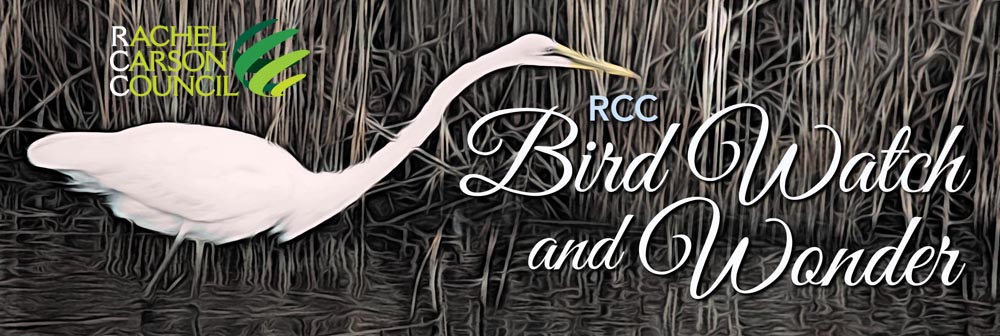 | | | May is the month for big-time bird migration! As our avian aviators head north, they have at least one thing on their minds — breeding. Yes. Sex. As in “the birds and the bees.” Singing their heads off, marking territory, building and repairing nests, bringing bugs and worms to the kiddies — keeping their species going amidst a warming planet and shrinking habitat. 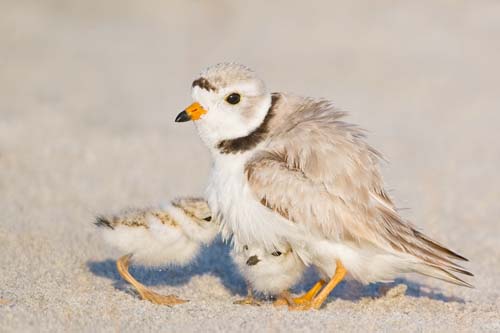 In this month’s RCC Bird Watch and Wonder, we document the decline of North American bird species and why it matters. But you and the birds deserve some good news, too. Among our favorite stories is the story of an adorable pair of Piping Plovers, Nish and Nellie. They are noodling and nesting in Ohio at Maumee Bay State Park where Piping Plovers have been absent for 83 years. These little birds who nest on beaches are beginning to rebound along our coasts thanks to concerted conservation efforts and the protections of the 1985 Endangered Species Act. In this month’s RCC Bird Watch and Wonder, we document the decline of North American bird species and why it matters. But you and the birds deserve some good news, too. Among our favorite stories is the story of an adorable pair of Piping Plovers, Nish and Nellie. They are noodling and nesting in Ohio at Maumee Bay State Park where Piping Plovers have been absent for 83 years. These little birds who nest on beaches are beginning to rebound along our coasts thanks to concerted conservation efforts and the protections of the 1985 Endangered Species Act.
Can you help? Read about how you can turn your own backyard into a mini-nature preserve for birds and other wildlife. Then you observe them up close and even start to draw them following David Sibley’s simple steps he offers in “The Art of Birds.” 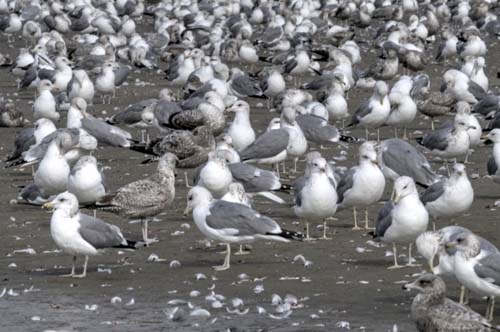 What to call all these birds, especially when they gang together in flocks and other gatherings. RCC’s own Ross Feldner offers another of his amusing and always interesting pieces on the incredible array of names for birds in groups far beyond a “murder of crows.” As Feldner puts it, amaze your friends at the beach when you say,” look at that squabble of gulls!” What to call all these birds, especially when they gang together in flocks and other gatherings. RCC’s own Ross Feldner offers another of his amusing and always interesting pieces on the incredible array of names for birds in groups far beyond a “murder of crows.” As Feldner puts it, amaze your friends at the beach when you say,” look at that squabble of gulls!”
And while the birds are at it as we head toward summer, humans also migrate to cooler climes and to the beach. Like birds and a good mystery? In our “Books” section, check out the collection of new “bird thrillers” there from your blanket or beach chair. Leave the Piping Plovers alone. And be sure to slather on sun block, wear sun protection gear, and create a backyard sanctuary when you get home… Keep reading | | | | | | | | | | 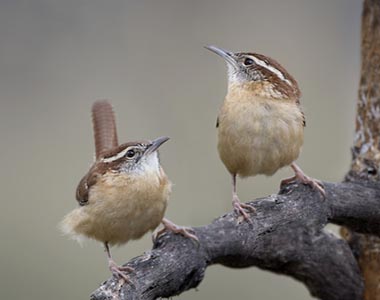 I Saw a Bird; Wednesdays I Saw a Bird; Wednesdays
The National Audubon Society’s weekly I Saw a Bird show brings the camaraderie and curiosity of the birding community into your home. Hosted by Audubon’s social media producer, Christine Lin, and chief network officer, David Ringer, I Saw a Bird showcases a fun, rollicking chat that is sure to educate and entertain. The first two episodes discussed spring migration and native plants, and featured guests including SNL’s Melissa Villaseñor and actress Lili Taylor. The show airs every Wednesday at 7 p.m. on Facebook Live and Zoom. More info: http://audubon.org/isawabird | | | | | | | | | | Major Threats to Birds Multiple interacting causes are likely behind bird population declines. Here are a few of the top threats. Habitats, the physical environments inhabited by living organisms, are fundamentally important to species’ survival. In the case of birds, habitats provide cover from predators; breeding, wintering, and migration stopover sites; and places to forage and roost. All of the habitats used by a bird play a role in its survival, and the loss or degradation of any one of them can potentially have a population-level impact. It is little surprise, then, that habitat loss is the greatest threat to birds. | | | | | | Silent Skies: Billions of North American Birds Have Vanished Though waterfowl and raptor populations have made recoveries, bird populations have declined since 1970 across nearly all habitats. More than half a century ago, conservationist Rachel Carson sounded an alarm about human impacts on the natural world with her book Silent Spring. Its title alluded to the loss of twittering birds from natural habitats because of indiscriminate pesticide use, and the treatise spawned the modern conservation movement. | | | | | | | | You Could Use Some Good Bird News Stop doom scrolling and check out these hopeful stories. The past year and a half has been challenging for all of us. The COVID-19 Delta variant and a sequence of extreme weather events intensified by climate change turned what was supposed to be a summer of vaccine-fueled celebration into something else entirely. It was a particularly tough season for birds and bird-lovers, as a mysterious epidemic sickened songbirds across the East and hundreds of chicks jumped from their nests during the Pacific Northwest’s record-breaking heatwave. The parade of bleak headlines marches on. | | | | | | | | Five Backyards That Birds Love Birds have four basic requirements for survival: food, water, cover, and places to raise young. Parks, refuges, and other protected areas fill these needs, and so can you. Just about any property — a backyard, a schoolyard, an apartment-building rooftop, you name it — can provide habitat for birds and other wildlife. In fact, more than 170,000 gardens and other green spaces across America have earned the National Wildlife Federation’s endorsement as Certified Wildlife Habitat. | | | | | | Six Ways to Support Wild Birds at Home Birds need our help. Since 1970, the North American bird population has lost almost 3 billion breeding adults, a loss of 29 percent over just fifty years. Habitat loss is one of the biggest reasons for the decline. Over the last five decades, the woodlands, grasslands, and coastal habitats that birds rely on have rapidly been converted into housing developments, industrial agriculture, and strip malls. Birds have lost nesting places and insect populations that birds rely on for food have begun disappearing as well. The native plant communities that supported birds are now lawns and asphalt. | | | | | | When You Should—and Should Not—Rescue Baby Birds It’s not uncommon to find young birds away from their nests during spring and summer. But should you help them? That depends. In the third grade, my teacher found what she thought was an abandoned baby bird on the school grounds. She asked if someone in the class would care for it, and days later, the European Starling I named Bluego (for a reason I wish I remembered) was living in a cardboard box in my bedroom, padded with fake spider web left over from Halloween. As a child, I was thrilled to be on my way toward becoming a wildlife rescuer, but years later I wondered if it was the right thing to do. | | | | | | | | Why We Need Birds (far more than they need us) Can you imagine a world without birds? The benefits birds bring us aren't just cultural. Birds play an essential role in the functioning of the world's ecosystems, in a way that directly impacts human health, economy and food production - as well as millions of other species. Here's how... It might be a little extreme to say that we’d be wading knee-deep in invertebrates if birds disappeared – but maybe not that extreme. A recent study has shown that birds eat 400-500 million tons of insects a year. | | | | | | | | | | Birds & Ecosystem Services Birds are present throughout almost every habitat across the globe. No matter where you go, there is always evidence of birds even if you don't see the animals themselves. Things like holes pecked in tree bark by woodpeckers or the remnants of a nest are indicative of the presence of birds. While such marks left behind by these animals may seem insignificant, in many cases the activities of birds can have large consequences for the ecosystems they inhabit, making them incredibly important in the overall functioning of various ecosystems. | | | | | | | | Some Birds Are Laying Eggs Earlier. Scientists are Paying Attention. Climate change may be causing birds that migrate to travel earlier to nesting areas. During a birdwatching stroll last spring, John Bates spotted a newly hatched killdeer chick. Common in North America, the long-legged birds often dart across the ground hunting for insects. Bates noted the date: April 30. Killdeer eggs take about 24 days to hatch, so this youngster must have come from an egg laid at the beginning of April. That’s roughly one month earlier than birds were laying eggs a century ago — a big difference, says Bates. He is curator of the Division of Birds at Chicago’s Field Museum. | | | | | | Twelve of Texas’s Most Stunning Birds The elusive bat falcon, the raucous chachalaca, and the luminous violet-crowned hummingbird belong on your life list. With a whopping 659 species, Texas is host to a stunning array of birds—a greater diversity than any other state except (alas) California. Birders here can find migratory species on their annual journey across the continent, coastal species living off rich Gulf ecosystems, rare desert birds hidden in the Chisos Mountains of West Texas, and grassland species dotting the plains. Here are a few of the top Texas fliers that Tiffany Kersten spotted during her record-breaking Big Year. | | | | | | | | Birds of a Feather Flock Together Ever wonder what a group of turkeys is called, or maybe a flock of gulls? Most of us have heard the term a gaggle of geese but what about a group of cardinals? Here’s a fun listing of names for various groups of birds. Many make perfect sense, but some are real head scratchers. Birds form clusters of organized groups, called flight flocks, for a reason. Most experts believe flocks increase the odds of survival and safety. The next time you’re at the beach impress your friends and say “will you look at that squabble of gulls!” | | | | | | Brains and Brawn Helped Crows and Ravens Take Over the World Crows and ravens are well known for their black color and the harsh "caw" sound they make. They are intelligent birds that use tools, solve complex abstract problems and speak a volume of words. But what is less well appreciated is how diverse they are. Their diversity is accompanied by their ability to live all over the world in a variety of habitats. In fact, they are one of the most widespread group of birds worldwide. Crows and ravens — part of the avian family of Corvids that also includes jays and magpies — underwent rapid global expansion. | | | | | | Funky Feathers: 10 Bizarre Birds A bird with body odor. Jaunty crests. Acrobatic pursuit of flying insects. The Doors famously asserted that no one remembers your name when you’re strange, a fact to which this odd editor can personally attest. Hopefully, though, you’ll remember the names of some of these aberrations of the avian world. The beautiful feathered freaks on this list deserve their day in the sun. | | | | | | | | Where Birds Meet Art . . . The Audubon Mural Project is a public-art initiative of the National Audubon Society and Gitler &_____ Gallery that draws attention to birds threatened by climate change. It started in the Harlem and Washington Heights neighborhoods of northern Manhattan, where pioneering bird artist John James Audubon once lived and is buried; dozens of birds now perch on doors, walls, and security gates in a several-block radius. The project is informed by Audubon’s groundbreaking science report "Survival By Degrees," which found that climate change will threaten 389 birds species—at least half of all North American birds—with extinction. | | | | | | Learn to Draw Birds with David Sibley The simple act of drawing can change the way you look at the world—and the way you understand birds. Get started with this video series. People often ask me which came first: my interest in drawing birds or watching birds. I have to answer, "both." The two things have always gone together for me, and they complement and support each other. Drawing forces me to look at a bird more completely and to ask questions that I would not have considered if I were just watching. In that sense, drawing becomes a way to interact with the bird. | | | | | |  | | | 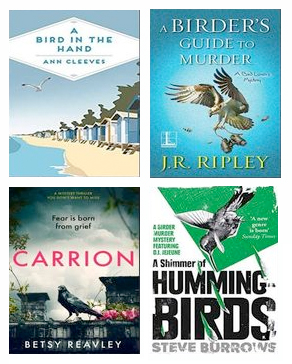 Eight Bird Thriller Books to Ruffle Your Feathers Eight Bird Thriller Books to Ruffle Your Feathers
These thrilling books will make you happy as a lark.
From Poe’s The Raven to Hitchcock’s The Birds, eerie avians are a well-trod tradition in mystery and horror. The birds depicted are often crows or ravens—in fact, the two are often mistaken for one another. They can present a frightening aura and are typically linked with death. It likely doesn’t help that a group of crows is called a murder, and are associated with battlefields and cemeteries. Crows and ravens are joined by owls, vultures, and blackbirds in their association with death and scavenging.
The birds in the books included in this roundup vary in association. From warblers, to chickadees, to cormorants—the bird’s the word. Whether you’re an early bird or a night owl, these thrillers and cozy birder mysteries will have you reaching for your binoculars rather than your magnifying glass. Read more | | | | | | | |  The Rachel Carson Council Depends on Tax-deductible Gifts From Concerned Individuals Like You. Please Help If You can. The Rachel Carson Council Depends on Tax-deductible Gifts From Concerned Individuals Like You. Please Help If You can. | | | |  Sign Up Here to Receive the RCC E-News and Other RCC Newsletters, Information and Alerts. Sign Up Here to Receive the RCC E-News and Other RCC Newsletters, Information and Alerts. | | | | | | | | | | | |